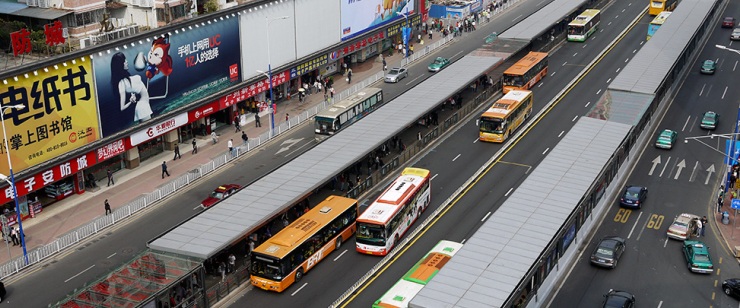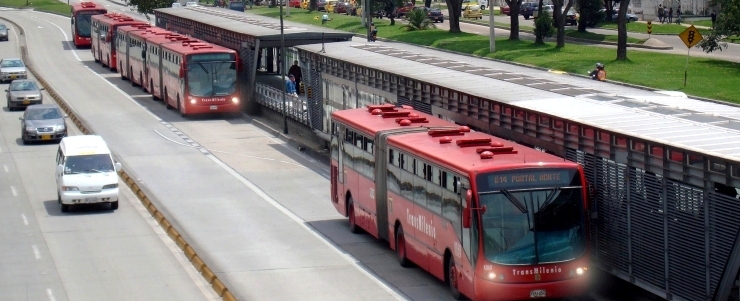Source: The Dirt – Connecting the Built & Natural Environments
Bus Rapid Transit (BRT) existed in just a few cities twenty years ago but has quickly turned into a viable solution for the massive transportation challenges facing cities. With more than half of the world now living in cities and total global population expected to reach nine billion, perhaps more cities should be looking at how to include BRT, a relatively cheap, sustainable, and flexible transportation option in comparison with building more highway overpasses and underground metro systems.
Dario Hidalgo from EMBARQ, the sustainable transportation think tank at the World Resources Institute (WRI), kicked off a session at Transforming Transportation 2011 by explaining that 120 cities now have BRT with bus corridors. Worldwide, there are now 200 dedicated bus corridors running over 4,000 kilometers. These networks have 7,000 stations, providing stops for 30,000 buses. Each day, 27 million people, or about one percent of the global urban population, is now riding BRT. Los Angeles, the site of one of the few major BRT systems in the U.S., is in the lead in terms of number of kilometers covered, but falls behind when considering the number of residents using the system each day. Both China and India are seeing exploding growth in BRT ridership.
In addition, more cities are catching on — more than 15 cities started BRT operations in 2010, representing 13 per cent growth over 2009. Another seven cities are expanding their systems, 49 cities have BRT under construction, and 31 are starting to plan out new systems. Still, with the rapid expansion of BRT, there are growing issues as well, including “rushed implementation, tight financial planning, high occupancy rates, deterioration of infrastructure, and fare system fragmentation.”
BRT Expands Across the Developing World
Walter Hook, head of the Institute for Transportation & Development Policy (ITDP), outlined some of the better designed BRT in developing countries as well as those facing challenges.
In Guangzhou, China, the BRT is a “hybrid full-featured direct service” system that carries some 800,000 passengers each day. Combined with a set of walkable, bikeable paths along the BRT stations, the system “has totally transformed the way the city feels.” The system is very smart: Existing municipal bus lines can rapidly enter and exit the dedicated BRT lane, which enables the city to leverage existing municipal “feeder” bus networks. Stations along the BRT route are off-set so there’s “more right of way.” In addition, BRT is integrated with the undeground metro system – “there’s a seamless network” and “no transfer penalty.”

Photo: Karl Fjellstrom, itdp-china.org
In contrast with Guangzhou’s system, TransJakarta, the BRT in Indonesia’s largest city, has had some teething pains. The buses run on clean natural gas (CNG), but the CNG refueling depots were placed way off the BRT paths, creating lots of logistical issues that raised the cost of running the network. While CNG was used to address Jakarta’s air quality issues, Hook says it’s important to deal with the “logistical problems” first when trying to reach environmental goals. In addition, lane enforcement in Jakarta has been “lax” in many places, meaning cars and bikes have taken over the lanes dedicated to rapid bus.
In Ahmedabad, India, there’s a 30 kilometer long system that serves 50,000 each day. It has all the features of BRT but includes new “squared roundabouts” that have been tricky because they require faster timing with traffic lights if only BRT is going to use them.
In Johannesburg, South Africa, Rea Vaya, Sub-Saharan Africa’s first BRT, is off to a solid start. Created in advance of the FIFA World Cup soccer tournament, Rea Vaya has “world class stations” and European buses. There are also plans to implement express and limited stop services, only possible because the city’s BRT infrastructure has multiple dedicated lanes. In addition, in some areas, stations were plopped down in the middle of one way streets, which was “very bold,” but they’ve largely worked.

Photo: Scania South Africa
Still, rolling out that city’s BRT system wasn’t easy. “There were regulatory and institutional issues,” largely due to the number of taxi associations involved and their ongoing wars with each other. “The taxi wars have led to a number of deaths.” One result of all of this has been revised certification processes for the city’s cabs, with the goal of making it easier to track cabs and deny some access to new BRT paths. This has been controversial because while denying cabs access to some routes is needed to preserve demand for BRT, it also means a loss of revenue for cab drivers. To address the cab drivers’ losses, the city had to spend extra, an almost 30-40 percent premium, to get the BRT in place.
Bogota’s Model BRT
Bogota’s BRT, TransMilenio, has been going for more than ten years now. There are 1.7 million daily trips but still “lots of politics” around BRT in the city, said the system’s general manager, Fernando Paez, largely because they’ve meant removing car lanes. The network is now 52 miles in length and will soon reach 72 miles. That’s just the first few phases — more than eight phases are planned. The city’s BRT has one control center, 1,215 buses and 515 feeder buses. More than a quarter of all bus trips in the city are now on TransMilenio’s dedicated lanes.
Interestingly, Paez said there were some two million square meters of public plazas and parks along the BRT network. When asked, Paez said the BRT network and plazas were developed together as part of an “integrated design strategy.” The adjacent parks and plazas help drive BRT usage. Research has been done on per capita usage of the public spaces around the BRT stations. In addition, Paez said they now have a “green street” pilot project along one of the lines to test how they can leverage the BRT infrastructure for stormwater management.

Photo: Transmilenio
Overall, there have been many upsides — economic development, an increased sense of civicness caused by the positive identity of the BRT, and improved safety and security. However, Paez said the city still needs to do more to “consolidate opportunities in urban development” offered by the BRT. Also, the city needs to increase the number of buses to deal with high occupancy rates, and address traffic control through feeder buses, an issue caused by congestion.
Implementing BRT in “Challenging Situations”
Colin Brader, a consultant for the World Bank, reviewed some challenges in implementing the BRT in Lagos, Nigeria and other cities like Jakarta and Johannesburg. He explained that “all have BRT in place so have been successful.” However, getting each system live “involved significant institutional or regulatory changes,” quite a bit of compromise, and flexibility so systems could “evolve to optimize and meet changing demands.”
Lagos residents previously faced horrendous travel conditions: Public buses had “variable fares,” passengers were subjected to “violence and intimidation,” and on top of that, there were “multiple transfer points.” A 12 kilometer ride could take 2-3 hours, certainly not unheard of in many big developing world cities like Bangkok. “Users want safety, security, and reliability” and the city largely gave them what they wanted. All major local politicians in the city got behind the concept, seeing it as a “people’s project,” and a massive consultation helped “depoliticize the implementation.”
Now Lagos’ BRT, which runs at 13 km per hour, has “dramatically improved” the lives of 170,000 people each day at a cost of $1.4 million per kilometer. In addition, it also exemplifies gender-sensitive design. Before the addition of queues, only the strongest could push their way aboard. “Women appreciated the imposition of the queuing systems.”
In a separate session, there was discussion on the need to collect better transportation data worldwide in order to build the case for more sustainable transportation options. While almost all countries have pretty good international air and rail travel data, very few have solid local data on walking, biking, or transit, which is crucial to putting funds behind more sustainable, low-cost urban options. Given good data is often at the foundation of good policy, more funds should be allocated to gathering and sharing data and even getting existing pockets of local data moved up to the national and international levels, enabling comparisons in the process.
One group, the Partnership on Sustainable Low-Carbon Transport, is calling for “Global Transportation Intelligence.” The Inter-American Development Bank also called for a set of urban “observatories” that can track transportation usage in cities and help inform sustainable transportation investments. As Sanjiv Lohia, Ministry of Urban Development in India, said, “instead of gazing at the stars, these observatories should be rooted at the ground level” where there is still so much unknown about human travel behavior.
¿Comments? ¿Opinions? ¿Similar News? Send them to us!












